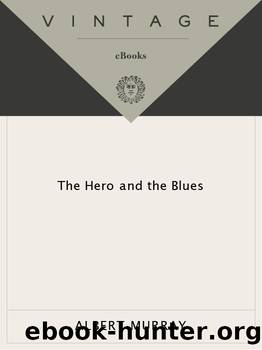The Hero and the Blues by Albert Murray

Author:Albert Murray [Murray, Albert]
Language: eng
Format: epub
ISBN: 978-0-307-82865-1
Publisher: Knopf Doubleday Publishing Group
Published: 2012-09-12T00:00:00+00:00
3.
THE BLUES AND THE FABLE
IN THE FLESH
André Malraux defines art as the means by which the raw material of human experience becomes style. He contends that stylization, whether abstract or representational, is the supreme objective of the creative process. He also maintains that the artist derives not from nature itself but from other artists and that the sense of life which any given artist expresses always involves an interaction with other works of art. âNever do we find an epochâmaking form built up without a struggle with another form,â he states and reiterates throughout The Voices of Silence; ânot one problem of the artistâs vision but is conditioned by the past.â Nor does there seem as yet to be any evidence from either archaeology or anthropology to refute him. âAlways,â he writes in reference to existing examples of prehistoric art such as the rock paintings of Rhodesia and the cave paintings of Altimire and Lascaux, âhowever far we travel back in time, we surmise other forms behind the forms which captivate us.â As for the modern folk or modern primitive art, he points out that for all their apparent crudeness, innocence, and assumed naturalness, such forms likewise follow conventions and traditions which it would be rash to ascribe to naïveté alone. âThe painters at our country fairs,â he adds as a reminder, âknow well what subjects are expected of them ⦠and what styles these call for.â
Applied to the art of fiction, Malrauxâs description of the dynamics of artistic creation suggests a practical point of departure which is both consistent with the history and geography of contemporary man and also commensurate with the complexity of contemporary experience and esthetic sensibility. Along with Malrauxâs conception of the museum without walls, which may well have been derived from long existing anthologies of world literature in the first place, this description also provides a working context within which the contemporary writer can come to practical terms with what is perhaps the most fundamental issue underlying every problem of craftsmanship involved in the actual process of literary composition: the functional relevance of literary tradition to the immediate requirements of vernacular communication.
T. S. Eliot addressed himself to what he defined as the problem of tradition and the individual talent and concluded that it was necessary for the writer to live in what is not merely the present but the present moment of the past. Tradition, he held, as did Thomas Mann in his essay âFreud and the Future,â is not something dead but rather that which is already living. In Eliotâs sense as in Malrauxâs, tradition is thus as much a part of the writerâs environment as anything else. âThe historical sense,â Eliot insisted, âcompels a man to write not merely with his own generation in his bones but with a feeling that the whole of the literature of Europe from Homer and within it the whole of the literature of his own country has a simultaneous existence and composes a simultaneous order.â The historical
Download
This site does not store any files on its server. We only index and link to content provided by other sites. Please contact the content providers to delete copyright contents if any and email us, we'll remove relevant links or contents immediately.
4 3 2 1: A Novel by Paul Auster(12233)
The handmaid's tale by Margaret Atwood(7645)
Giovanni's Room by James Baldwin(7123)
Asking the Right Questions: A Guide to Critical Thinking by M. Neil Browne & Stuart M. Keeley(5583)
Big Magic: Creative Living Beyond Fear by Elizabeth Gilbert(5562)
Ego Is the Enemy by Ryan Holiday(5236)
The Body: A Guide for Occupants by Bill Bryson(4893)
On Writing A Memoir of the Craft by Stephen King(4830)
Ken Follett - World without end by Ken Follett(4602)
Adulting by Kelly Williams Brown(4444)
Bluets by Maggie Nelson(4437)
Eat That Frog! by Brian Tracy(4392)
Guilty Pleasures by Laurell K Hamilton(4285)
The Poetry of Pablo Neruda by Pablo Neruda(3998)
Alive: The Story of the Andes Survivors by Piers Paul Read(3929)
White Noise - A Novel by Don DeLillo(3920)
Fingerprints of the Gods by Graham Hancock(3906)
The Book of Joy by Dalai Lama(3862)
The Bookshop by Penelope Fitzgerald(3728)
